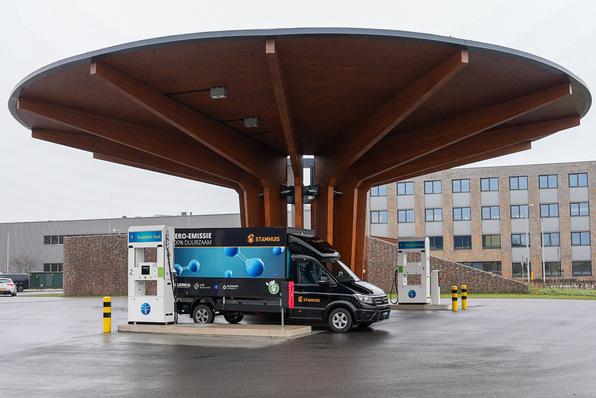On behalf of the Federal Ministry for Economic Affairs and Energy (BMWE), BET Consulting and the Institute of Energy Economics at the University of Cologne (EWI) compiled a report summarising the status of various energy transition studies and developing scenarios.. Rather than a monitoring report, the term meta-study would be more appropriate, as the report does not really contain any new findings. However, it serves well as an overview, particularly in visualising the range of projections.
The scenarios in the report are divided into “normative scenarios,” which are calculated to meet binding climate targets, and “exploratory scenarios,” which illustrate possible alternative developments that mostly fall short of these targets. One of the seven focus chapters deals with the hydrogen ramp-up. EWI was responsible for this chapter.
Status quo: wide range of hydrogen scenarios, prices too high
Even within the normative scenarios, the projected hydrogen demand for 2045 (the year in which climate neutrality is to be reached in Germany) varies widely, ranging from 150 to 650 TWh. For storage requirements in 2045, the report cites a similarly broad range, from 30 to 130 TWh. In all scenarios, both normative and exploratory, the authors assume that hydrogen will primarily be used in industry and the energy sector. The volumes required for buildings and transport, on the other hand, are described as “not significant.”
The authors also note that there is “hardly any market-side demand,” as hydrogen is, in short, too expensive. This could be changed by cheaper electricity and economies of scale in electrolysers and infrastructure – but that would in turn require an increase in demand. They also observe that hydrogen imports appear to be cheaper than domestic production in most studies. However, domestic production could contribute to flexibility and security of supply. Since the hydrogen core network is based on market surveys, announced projects and political targets, it would become economically inefficient if these do not materialise.
Policy options: what do the experts propose?
In addition to the analysis, the report also addresses the political options available. The focus is explicitly on the interlinking of various topics, such as electricity generation, grid expansion and the hydrogen ramp-up.
The authors propose a number of measures that would be important for scaling up hydrogen. For example, the expansion of electrolysers could be spatially coordinated so that the need for grid expansion is minimised on both the electricity and hydrogen sides. However, the authors admit that it remains unclear how this would work in practice if the hydrogen is not needed right next to the wind farm. Compromises would need to be found as either electricity or hydrogen would have to be transported through grids.
Electrolysers could also be operated in a “system-serving” manner. However, the report notes that this term would first need to be clearly defined. And even here, there could be a conflict of objectives: if electrolysers are mainly used during hours of high renewable electricity production, the full-load hours of the electrolyser decrease and hydrogen costs increase.
Reducing the cost of hydrogen supply is, of course, also a key issue. The report suggests continuing to provide funding in order to achieve economies of scale and thus lower costs. In terms of regulation, the report reiterates familiar demands: the EU requirement for additionality of renewable electricity could be removed, as could grid fees and government-imposed electricity price components. The use of redispatch electricity volumes could be made free of charge or offered at low cost.
There are also chapters dealing with demand-side management and storage, as no market can emerge without demand. Tenders for hydrogen-ready gas-fired power plants are one such topic. The prerequisite, of course, is that hydrogen must be available at the respective location. The authors thus highlight many well-known dilemmas – and make proposals for how the government can intervene, even if decisions must be made under a certain degree of uncertainty.
Katherina Reiche’s hydrogen plan: handling targets “flexibly”
The Federal Ministry of Economic Affairs presented a total of ten measures for the realignment of the energy transition yesterday. The ninth of these is titled “We support hydrogen and reduce overly complex regulations.” The ministry’s website states that “clarity must be created.” As in the coalition agreement, it is striking what is not being said.
In a video Reiche makes clear: not much is going to happen here, especially not in terms of clear targets or commitments. At least Reiche picks up on one long-standing demand from the industry. The “strict definition of green hydrogen at EU level” must be dismantled and replaced with “pragmatic criteria.” In other words, the EU can be blamed, and the abolition of the additionality requirement can be demanded. Reiche says nothing about reducing government-imposed price components, which Germany could decide on itself.
Reiche also says she wants to handle goals that were set by the prior government more “flexible“. The focus should be on markets where there is already a willingness to pay for hydrogen or where this can be achieved with “responsible” means. She cites refineries as an example. Power plants, trucks, steelworks or other areas of application are not mentioned.
The hydrogen core network, import corridors and the development of hydrogen potential abroad are to be implemented “step by step” and in close coordination with the demand side. Reiche wants to replace the current expansion targets for electrolysers with “flexible targets” based on demand-side projects. Infrastructure projects such as “H2-Valleys” are to be launched “as needed.”









